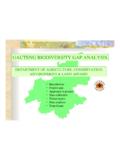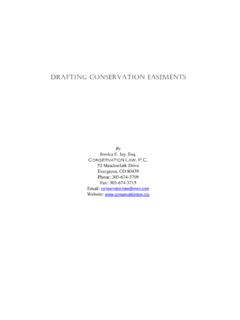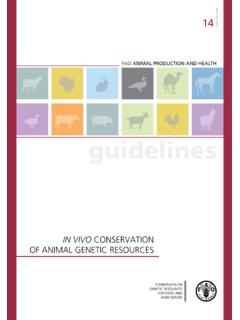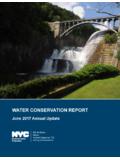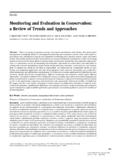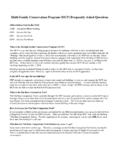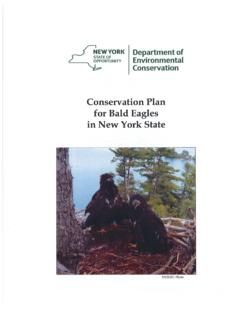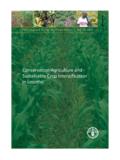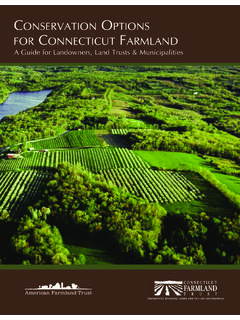Transcription of GAUTENG BIODIVERSITY GAP ANALYSIS - …
1 Introduction)Project aim)Approach to project)Data collection)Threat layers)Data ANALYSIS )Time frameENVIRONMENT & LAND AFFAIRSGAUTENG BIODIVERSITY GAP ANALYSISDEPARTMENT OF AGRICULTURE, conservation , INTRODUCTIONP olicy context)South Africa is a signatory to the United Nations Convention onBiological Diversity and is therefore committed to ensuring its objectives are met.)The White Paper on the conservation and Sustainable Use of South Africa s Biological Diversity describes South Africa s approach to upholding this Convention.)The BGAP addresses the first of the goals listed in the White Paper, to conserve the diversity of landscapes, ecosystems, habitats, communities, populations, species and genes in South defined)The variety and variability among living organisms and the ecological complexes in which they occur.)The term encompasses different levels of organization including landscapes, communities, species, populations, individual organisms and genes.
2 Ecological processes are also of GAUTENG )Although the smallest province in SA, Gautengis characterized by a high BIODIVERSITY .)Gautengfalls within both the savanna and highly threatened grassland biomes that together constitute six vegetation types.)Approximately 83% of the province falls within HighveldGrassland, of which an estimated is currently conserved in SA.)An estimated 3303 plant species, 125 mammal species, 483 bird species, 23 amphibian and 101 reptile species occur in the province.)25 plant species are endemic or near endemic to the province, all of them threatened with extinction with at least 56% Critically Endangered or and challenges)There is a serious lack of up-to-date information on the BIODIVERSITY of GAUTENG ; information that does exist is associated with sampling bias, is outdated or has been recorded at too coarse a scale ( quarter degree grids).
3 The province has the highest human population density and the highest urbanization levels in the country.)The BIODIVERSITY of Gautengis highly threatened by industrialization, mining, agriculture and especially urbanization.)Successful conservation of BIODIVERSITY requires the identification and mapping of priority areas where development and habitat transformation and fragmentation should be discouraged and conservation efforts should be AIMTo identify and map the distribution of areas that are of importance to BIODIVERSITY in Gautengthrough a conservation planning exercise that is based on explicit representation goals and the principles of:)complementarity(avoidance of duplication of important attributes),)efficiency (most protection for the least cost/area),)defensibility and flexibility (many combinations of potential solutions in the face of competing land uses),)irreplaceability,)retention (consideration of threatening factors),)persistence (capturing of ecological processes and exclusion ofthreats) and)accountability (in allowing decisions to be critically reviewed) and ultimately to provide recommendations for the conservation and management of these TO PROJECTThe history of conservation planningIn the past, conservation areas were not established with BIODIVERSITY criteria under consideration in many southern African countries, protected areas were established for the sole purpose of conserving larger mammal species.
4 conservation planning exercises targeting solely the species level of BIODIVERSITY .)More studies targeting the level of communities, habitats, ecosystems and landscapes.)More thorough studies targeting both lower and higher levels ofbiodiversity. Focusing on both species and higher organizational levels should help integrate patterns and processes into conservation trends in conservation planningGautengBGAP projectsite irreplaceabilitymapsite databasesite by feature databasefeature databaseconservation planmanagement & policy strategiesconservation targetsvulnerability ratingsGIS shape filesThreat layersMedicinal plant useVarroainfestationOthersConservation areasHabitat diversity and processesRidgesCavesRiversWetlandsBiodiv ersityFloraInvertebratesBirds, reptiles and amphibiansMammalsFishThreat layersMedicinal plant useVarroainfestationOthersBiodiversityFl oraInvertebratesBirds.
5 Reptiles and amphibiansMammalsFishBiodiversity Information Management SystemdatabaseGIS shape filesConservation areasHabitat diversity and processesRidgesCavesRiversWetlandsconser vation targetsvulnerability ratingsBiodiversity Information Management Systemdatabasesite databasesite by feature databasefeature databasesite irreplaceabilitymapconservation planmanagement & policy strategiesDATA COLLECTIONDATA CAPTUREDATA ANALYSIS IN C-PLANR idges layer)Using a GIS digital elevation model, all ridges mapped.)A histogram ANALYSIS of five major ridge systems in the province indicated that the minimum slope of a ridge is 5 (contour intervals of 20m at 1:50 000 scale).))Class 1 & 2 ridgesClass 1 & 2 ridges: Conserve 100% of all untransformedareas)Class 3 & 4 ridgesClass 3 & 4 ridges: Conserve 100% of all untransformed portions >4haClass 1 Class 2 Class 3 Class 4 Sensitivity classesRivers layer(PietM ller) The National River Health Programmecontributes to this layer.
6 Involves the biological monitoring of all the aquatic drainage systems in Gautengby means of standardized survey techniques. Target: Conserve 100% of all rivers. 100m buffer against edge effects and for rough approximation of1:100 year floodline. RiverineVegetation Index: Surveying of riverinevegetation South African Scoring system version 4: Surveying of aquatic invertebrates Fish Assemblage Integrity Index: Surveying of fish populationsWetland layer(ReggyNkosi) Current GIS data on wetlands in Gautengobtained fromwill be updated and verified. Target: Conserve 100% of all wetlands. 100m buffer against edge effects and for rough approximation of 1:100 year floodline. 1:50 000 maps Aerial photographis Orthophotos 2000 Landcover wetland mapping projectFlora layer(Mich lePfab)Plant communities All untransformed natural/semi-natural vegetation in Gautengclassified into component plant communities using LANDSAT 7 satellite imagery and ground truthing.
7 All Red Data plant populations in Gautengmapped using a GPS and suitable habitat modeled. The vegetation type/community and species/population layers combined in a GIS to form flora diversity plant populationsInvertebrate layer(Marianne Forsyth) Targets threatened and endemic species as well as functional groups (pollinators, seed dispersers, predators, biomass and soil workers). Sampling using baited pitfalls, vegetation sweeps, malaise trapping, aerial sweeps, baited butterfly traps, night light traps, hand collection and honeybee catch boxes. Identification of material to genus and species level outsourced to copper butterflyHEIDELBERGB irds, reptiles & amphibians layer(Craig Whittington-Jones) All existing information collated. Species prioritized using criteria such as endemism, Red Data status and conservation importance in GAUTENG . All habitat types in each quarter degree grid square sampled atleast once from October to April of each year.
8 Surveying of reptiles and amphibians involves both active and passive capture techniques. A bird atlas underway in co-operation with BirdLifeSouth Africa and local Gautengbird clubs. Field surveys of birds involve line transects through each habitat layer(Dean Peinke) All existing information collated. All naturally occurring free-ranging mammal species prioritized. All habitat types in each quarter degree grid square sampled atleast once from October to April of each year. Shrews, elephant shrews and small rodents sampled using small mammal traps. Mole traps set in areas where mole activity is observed. At least four hours a night allocated to bat sampling using theAnabatII bat detector and mist netting. Small and large carnivore traps set at suitable sites. Spotlight surveys for nocturnal species. All diurnal species encountered during active searches recordedas well as spoor, droppings, feeding signs, burrows, etc.
9 Habitat suitable for Red Data species afforded specific s golden moleBRONBERGT hreat layers Agricultural potential Climate change Habitat transformation Invasive fauna and flora Medicinal plant use (Pat Matsau) Mining Pollution Roads (future) Urban development VarroainfestationSystematic conservation planning to be used as surrogates for overall BIODIVERSITY goals, translated into quantitative operational targets, to which conservation goals met in existing reserves , explicit methods used for locating and designing new reserves to complement existing ones in achieving criteria for implementing conservation action on the ground objectives and mechanisms for maintaining conditions within reserves adopted, together with monitoring and adaptive management as )Inherent in any data set, irreplaceabilityis the major constraint on selecting new areas to achieve representation targets not met by existing conservation areas.
10 The irreplaceabilitymap produced through the C-plan exercise indicates for each of the areas in a planning region the options for replacingit while still achieving conservation targets.)Irreplaceable areas have no replacements, whereas others have many.)Choosing between alternative replacements can be based on land tenure, threatening factors, trade-offs between opportunity costs and BIODIVERSITY gain and the position of existing conservation areas in relationto alternatives.)Areas characterized by high irreplaceabilityvalues and high vulnerability ratings should receive priority conservation Priority sitesConservation plan: Version 1 IrreplaceableImportantConservation areasPROJECT OUTPUTSA Gautengconservation plan indicating areas important for the conservation of biological diversity where/that:)New provincial nature reserves or other legislated protected areas should be established.
